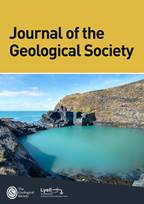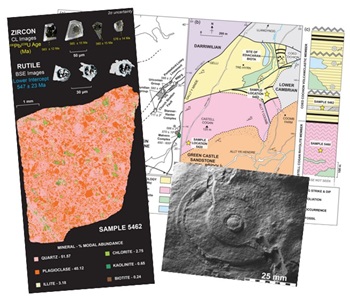
Journal of the Geological Society (JGS) is owned and published by the Geological Society of London.
JGS publishes topical, innovative and interdisciplinary research with global reach across the full range of Earth and planetary sciences. Regional geological studies of interest to our international readership are also welcomed.
Each year JGS presents the ‘JGS Early Career Award' for papers published in the journal, which rewards the writing of well-written, exciting papers from early career geologists.
The journal publishes research and invited review articles, discussion papers and thematic collections.
Journal of the Geological Society is a Plan S compliant journal.
JGS Editor-in-Chief
The Editor-in-Chief Yildirim Dilek (Miami University, USA) is supported by Deputy Editors Anna Bird (University of Hull, UK), Lorenzo Fedele (Università degli Studi di Napoli Federico II, Italy), Andrea Festa (University of Turin, Italy), Matías Ghiglione (Buenos Aires University, Argentina), and an international Editorial Board.
Online in the Lyell Collection
All journal content is hosted online and accessible via the Lyell Collection. The journal publishes 6 issues per year.
Online only and continuous publication
From 2021, the journal is published online only. Following acceptance, the accepted manuscript version of the article is made available online immediately. After completion of the production process, the final Version of Record is published directly in an issue. All accepted manuscripts and versions of record are hosted and accessible via the Lyell Collection.
The journal is abstracted and/or indexed in:
- Current Contents
- GeoArchive
- Geobase
- Geological Abstracts
- GeoRef
- Mineralogical Abstracts
- Petroleum Abstracts
- Science Citation Index
Published today
Scottish and Irish rocks confirmed as rare record of ‘snowball Earth’
A rock formation spanning Ireland and Scotland may be the world’s most complete record of “snowball Earth”, a crucial moment in planetary history when the globe was covered in ice, finds a new study led by UCL researchers.
The study, published in the Journal of the Geological Society, found that the Port Askaig Formation, composed of layers of rock up to 1.1km thick, was likely laid down between 662 to 720 million years ago during the Sturtian glaciation – the first of two global freezes thought to have triggered the development of complex, multicellular life.
One exposed outcrop of the formation, found on Scottish islands called the Garvellachs, is unique as it shows the transition into “snowball Earth” from a previously warm, tropical environment.
Other rocks that formed at a similar time, for instance in North America and Namibia, are missing this transition.
Senior author Professor Graham Shields, of UCL Earth Sciences, said: “These rocks record a time when Earth was covered in ice. All complex, multicellular life, such as animals, arose out of this deep freeze, with the first evidence in the fossil record appearing shortly after the planet thawed.”
First author Elias Rugen, a PhD candidate at UCL Earth Sciences, said: “Our study provides the first conclusive age constraints for these Scottish and Irish rocks, confirming their global significance.
“The layers of rock exposed on the Garvellachs are globally unique. Underneath the rocks laid down during the unimaginable cold of the Sturtian glaciation are 70 metres of older carbonate rocks formed in tropical waters. These layers record a tropical marine environment with flourishing cyanobacterial life that gradually became cooler, marking the end of a billion years or so of a temperate climate on Earth.
“Most areas of the world are missing this remarkable transition because the ancient glaciers scraped and eroded away the rocks underneath, but in Scotland by some miracle the transition can be seen.”
The Sturtian glaciation lasted approximately 60 million years and was one of two big freezes that occurred during the Cryogenian Period (between 635 and 720 million years ago). For billions of years prior to this period, life consisted only of single-celled organisms and algae.
After this period, complex life emerged rapidly, in geologic terms, with most animals today similar in fundamental ways to the types of life forms that evolved more than 500 million years ago.
One theory is that the hostile nature of the extreme cold may have prompted the emergence of altruism, with single-celled organisms learning to co-operate with each other, forming multicellular life.
The advance and retreat of the ice across the planet was thought to have happened relatively quickly, over thousands of years, because of the albedo effect – that is, the more ice there is, the more sunlight is reflected back into space, and vice versa.
Professor Shields explained: “The retreat of the ice would have been catastrophic. Life had been used to tens of millions of years of deep freeze. As soon as the world warmed up, all of life would have had to compete in an arms race to adapt. Whatever survived were the ancestors of all animals.”
For the new study, the research team collected samples of sandstone from the 1.1km-thick Port Askaig Formation as well as from the older, 70-metre thick Garbh Eileach Formation underneath.
They analysed tiny, extremely durable minerals in the rock called zircons. These can be precisely dated as they contain the radioactive element uranium, which converts (decays) to lead at a steady rate. The zircons together with other geochemical evidence suggest the rocks were deposited between 662 and 720 million years ago.
The researchers said the new age constraints for the rocks may provide the evidence needed for the site to be declared as a marker for the start of the Cryogenian Period.
This marker, known as a Global Boundary Stratotype Section and Point (GSSP), is sometimes referred to as a golden spike, as a gold spike is driven into the rock to mark the boundary.
GSSPs attract visitors from around the world and in some cases museums have been established at the sites.
A group from the International Commission on Stratigraphy, a part of the International Union of Geological Sciences, visited [July 18-19] the Garvellachs in July to assess the case for a golden spike on the archipelago. Currently, the islands are only accessible by chartering a boat or by sailing or kayaking to them.
The study involved researchers from the UCL, the University of Milano-Bicocca, Italy, and Birkbeck University of London. The work was funded by the Natural Environment Research Council (NERC).
Glacially influenced provenance and Sturtian affinity revealed by detrital zircon U–Pb ages from sandstones in the Port Askaig Formation, Dalradian Supergroup
By Elias J. Rugen, Guido Pastore, Pieter Vermeesch, Anthony M. Spencer, David Webster, Adam G. G. Smith, Andrew Carter and Graham A. Shields
Read the paper in full in the Lyell Collection by clicking here
Key moment in the evolution of life on Earth captured in fossils

Research published in the Journal of the Geological Society has for the first time precisely dated some of the oldest fossils of complex multicellular life in the world, helping to track a pivotal moment in the history of Earth when the seas began teeming with new lifeforms - after four billion years of containing only single-celled microbes.
Lead author PhD student Anthony Clarke, from the Timescales of Mineral Systems Group within Curtin’s School of Earth and Planetary Sciences, said to determine the age of the fossils, researchers used volcanic ash layers like bookmarks in the geological sequence.
“Located in the Coed Cochion Quarry in Wales, which contains the richest occurrence of shallow marine life in Britain, we used outfall from an ancient volcano that blanketed the animals as a time marker to accurately date the fossils to 565 million years, accurate down to 0.1 per cent,” Mr Clarke said.
“With similar Ediacaran fossils found at sites around the world including in Australia, dating the fossils identifies them as being part of an ancient living community that developed as Earth thawed out from a global ice age.
“These creatures would in some ways resemble modern day marine species such as jellyfish, yet in other ways be bizarre and unfamiliar. Some appear fern-like, others like cabbages, whereas others resembled sea pens.”
Study co-author Professor Chris Kirkland, also from the Timescales of Mineral Systems Group at Curtin, said the fossils are named after the Ediacara Hills in South Australia’s Flinders Ranges, where they were first discovered, leading to the first new geological period established in over a century.
“These Welsh fossils appear directly comparable to the famous fossils of Ediacara in South Australia,” Professor Kirkland said.
“The fossils, including creatures like the disc-shaped Aspidella terranovica, showcase some of the earliest evidence of large-scale multicellular organisms, marking a transformative moment in Earth’s biological history.
“Ediacaran fossils record the response of life to the thaw out from a global glaciation, which shows the deep connection between geological processes and biology.
“Our study underscores the importance of understanding these ancient ecosystems in order to unravel the mysteries of Earth’s past and shape our comprehension of life’s evolution.”
The full research paper, ‘U–Pb zircon-rutile dating of the Llangynog Inlier, Wales: constraints on an Ediacaran shallow 1 marine fossil assemblage from East Avalonia’ was published in the Journal of the Geological Society and can be found online here